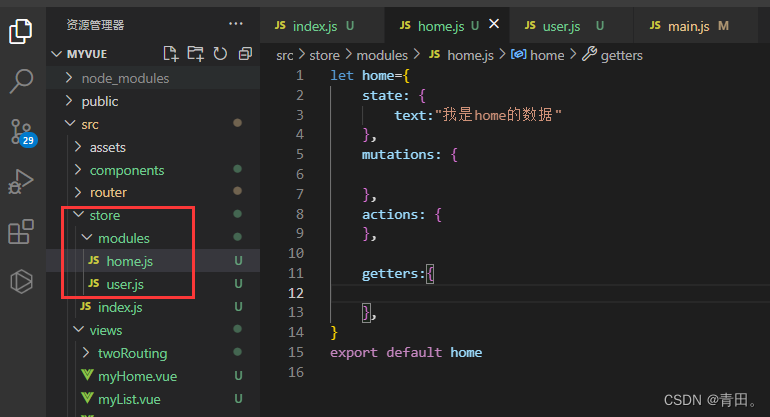一、解释
vuex 状态(数据)管理工具 。 vuex 可以把整个项目的数据集中的管理起来 方便组件与组件的使用 (组件想使用数据 那么不需要使用 复杂的传递方式了 直接就可以去vuex中进行数据 的获取)
传统的vue 是单向数据流 如果是兄弟或者是跨层级的组件在进行传递的时候vue就非常的麻烦vuex就可以来进行上述传值 简化数据传递的复杂度。
二、vuex创建流程
①第一种 创建项目时选中Vuex

② 第二种 指令下载
npm install --save vuex
在src文件夹下新建store文件夹并且新建index.js
import Vue from 'vue'
import Vuex from 'vuex'
Vue.use(Vuex)
export default new Vuex.Store({
})在main.js 中引用vuex文件 并且在vue实例上注册
import Vue from 'vue'
import App from './App.vue'
import router from './router'
import store from './store'//引用
Vue.config.productionTip = false
new Vue({
router,
store,//注册
render: h => h(App)
}).$mount('#app')三、vuex的5大属性
1、state属性---数据源(创建数据的 类似于组件中的data)
vuex的所有数据都在state中进行创建
import Vue from 'vue'
import Vuex from 'vuex'
Vue.use(Vuex)
export default new Vuex.Store({
state: {
text:"小王",
age:18,
arr:[111,222,333],
obj:{
love:"女"
}
},
mutations: {
},
actions: {
},
modules: {
}
})① 取值方式1 ----任意组件模板上直接使用 $store.state.xxx使用
<template>
<div>
拿text的值{{$store.state.text}}
</div>
</template>
<script>
export default {
}
</script>
<style>
</style>②.取值方式2 ---使用计算属性来进行vuex的数据获取
<template>
<div>
拿age的值{{newage}}
</div>
</template>
<script>
export default {
computed:{
newage(){
return this.$store.state.age
}
}
}
</script>
<style>
</style>2、mutations属性---vuex的数据修改
vuex中state的数据不能直接修改 如果要触发mutations的修改动作 那么要使用commit这个方法来进行调用
比如把小王修改为小黑
第一步、通过事件触发commit来调用修改操作
<template>
<div>
home页面{{$store.state.text}}
<button @click="fun()">点我修改</button>
</div>
</template>
<script>
export default {
methods:{
fun(){
// 需要触发这个函数之后把vuex的text变量进行修改
// this.$store.commit("你要调用的mutations的名字",传递的参数)
//第一种写法:
this.$store.commit("uptext",{newtext:"小黑"})
//第二种写法:推荐写对象的形式
this.$store.commit({
type:"uptext",
newtext:"小白"
})
}
}
}
</script>
<style>
</style>第二步去store中编写对应的mutations修改动作
import Vue from 'vue'
import Vuex from 'vuex'
Vue.use(Vuex)
export default new Vuex.Store({
state: {//创建数据的类似于组件中的data
text:"小王",
age:18,
arr:[111,222,333],
obj:{
love:"女"
}
},
mutations: {
// 第一个形参state就是指向上面的state数据源
// 第二个形参接收的就是commit方法中的第二个参数
uptext(state,payload){
state.text = payload.newtext
}
},
actions: {
},
modules: {
}
})vuex数据修改后 刷新丢失
在vuex中如果我们修改数据之后 页面在刷新一次 那么页面的数据你会回复成默认值
created() {
//在页面加载时读取sessionStorage里的状态信息
if (sessionStorage.getItem("store")) {
this.$store.replaceState(
Object.assign(
{},
this.$store.state,
JSON.parse(sessionStorage.getItem("store"))
)
);
}
//在页面刷新时将vuex里的信息保存到sessionStorage里
window.addEventListener("beforeunload", () => {
sessionStorage.setItem("store", JSON.stringify(this.$store.state));
});
},3、actions属性------触发异步操作
actions中是一个个的方法 每一个方法就是一个异步的动作 (异步请求)
actions调用的话 使用dispatch( ) 来进行调用
1.页面通过dispatch来触发actions
<template>
<div>
user页面{{$store.state.text}}
<button @click="fun()">点我触发异步操作</button>
</div>
</template>
<script>
export default {
methods:{
fun(){
// 调用actions
// this.$store.dispatch("你出发的actions的名字",{数据})
//写法一:
//this.$store.dispatch("demoLink",{url:"/data/data"})
//写法二:推荐写为对象的形式
this.$store.dispatch(
{
type:"getMenuList",
url:"/data/list/menu"
}
)
}
}
}
</script>2、actions创建对应的方法
import Vue from 'vue'
import Vuex from 'vuex'
// 引用数据请求
import getlink from "@/apis/getapi.js"
Vue.use(Vuex)
export default new Vuex.Store({
state: {//创建数据的类似于组件中的data
text:"小王",
age:18,
arr:[111,222,333],
obj:{
love:"女"
}
},
mutations: {
uparr(state,payload){
//把请求来的数据修改state
state.arr=payload.arrdata
}
},
actions: {
// context形参 就是store对象
// 第二个形参接收的就是dispatch
demoLink(context,payload){
console.log("context")
//发送异步操作
getlink(payload.url).then((res)=>{
console.log(res.data.data)
//把请求来的数据交给mutations来修改state
context.commit("uparr",{arrdata:res.data.data})
})
}
},
modules: {
}
})3、在页面展示请求来的新的arr
<template>
<div>
{{newarr}}
</div>
</template>
<script>
export default {
computed:{
newarr(){
return this.$store.state.arr
}
},
}
</script>
<style>
</style>4、getters属性 -- 类似于计算属性
getters 可以对一个数据在不同位置展示出不同的形态时候用
getters 处理的数据 任何组件都能用
vue的计算属性处理的数据 只能当前组件使用
import Vue from 'vue'
import Vuex from 'vuex'
Vue.use(Vuex)
export default new Vuex.Store({
state: {//创建数据的类似于组件中的data
demo:"abcde"
},
mutations: {
},
actions: {
},
modules: {
},
getters:{
// 里面就一个形参 state代表的就是数据源
newdemo(state){
return state.demo.toUpperCase()
}
}
})把demo的小写处理为大写后在页面去用(组件里使用getters时不加模块名)
<template>
<div>
home页面
<h1>{{$store.getters.newdemo}}</h1>
</div>
</template>
<script>
export default {
}
</script>
<style>
</style>5、module 模块
可以把上面写在一起的数据 修改 异步操作 计算属性 按照页面等进行分类管理
第一步 home页面user页面分开管理

第二步 在index.js把模块注入到vuex中
import Vue from 'vue'
import Vuex from 'vuex'
// 引用模块
import Home from "./modules/home.js"
import User from "./modules/user.js"
Vue.use(Vuex)
export default new Vuex.Store({
// 注入
modules: {
Home ,
User
}
})第三步 使用数据 $store.state.模块名.xxx
<template>
<div>
home页面
<h1>{{$store.state.Home.text}}</h1>
</div>
</template>
<script>
export default {
}
</script>
<style>
</style>问题:如果home和user两个模块里有相同action(mutation)的名字


结果是两个都会调用,那么如何区分????
添加 namespaced: true 的方式使其成为带命名空间的模块

两个都要开启。开启后变为严格模式必须加模块名字

getters重名区分的话 也要加模块名
{{$store.getters["Home/newdemo"]}}
{{$store.getters["User/newdemo"]}}
问题:这样写太繁琐(冗余)

辅助函数 http:// https://vuex.vuejs.org/zh/guide/state.html
mapState, mapGetters (这两个在computed里映射)
mapMutations, mapActions(这两个在methods里映射)
假如index.js 里 (没分模块化)
import axios from "axios";
import Vue from "vue";
import Vuex from 'vuex'
import Home from "./home.js"
import User from "./user.js"
// 1.安装
Vue.use(Vuex)
// 2.创建对象
export default new Vuex.Store({
state: {
demo:"abc",
num:0,
num1:"1",
num2:"2",
num3:"2",
age:18,
},
mutations: {
},
actions: {
},
getters: {
newDemo(state){
return state.demo.toUpperCase()
}
},
modules: {
Home,
User
}
})使用辅助函数
<template>
<div>
demoVuex:
<!-- <h3>{{num}}</h3> -->
<h3>{{num1}}</h3>
<h3>{{num2}}</h3>
<h3>{{num3}}</h3>
<h3>newDemo:{{newDemo}}</h3>
</div>
</template>
<script>
import { mapState,mapGetters } from "vuex";
export default {
data(){
return{
}
},
methods:{
},
computed:{
...mapState(['num1','num2','num3']),
...mapGetters(["newDemo"])
},
//这种写法也可以但(不能再写其它计算属性)
// computed:mapState({
// num:state=> state.num
// }),
}
</script>
区分模块化
<template>
<div>
demoVuex
<h4>{{newDemo}}</h4>
</div>
</template>
<script>
import { mapState,mapGetters } from "vuex";
export default {
data(){
return{
}
},
methods:{
},
computed:{
// 未加模块名
...mapState(['num1','num2','num3']),
// 加模块名
// 语法:...mapState("模块名",['要取的值']),
// 注:这种取值方式需要在对应的模块下开启命名空间即在Home模块下加 namespaced:true,
...mapState("Home",['homeMoudel']),
// 未加模块名
...mapGetters(["newDemo"]),
// 加了模块名
// ...mapGetters("模块名",[模块里的getters])
...mapGetters("Home",["newdemo"])
},
}
</script>
mapActions
① 不区分模块index.js
actions: {
getMenuList(){
axios({
url:'/data/list/menu'
}).then(res=> {
console.log('res',res);
})
}
},使用时候
<template>
<div>
<input type="button" value="按钮" @click="handleAxios()">
</div>
</template>
<script>
import { mapState,mapGetters,mapActions } from "vuex";
export default {
data(){
return{
}
},
methods:{
// 把getMenuList映射到当前组件的methods中
...mapActions(["getMenuList"]),
handleAxios(){
this.getMenuList({id:123}) //类似this.$store.dispatch()
},
}
}
</script>区分模块化 ...mapActions({"名字":"模块名/actions下的方法名"}),
<template>
<div>
<input type="button" value="按钮" @click="handleAxios()">
</div>
</template>
<script>
import { mapState,mapGetters,mapActions } from "vuex";
export default {
data(){
return{
}
},
methods:{
// 不分模块方式:把getIndexAction映射到当前组件的methods中
...mapActions(["getIndexAction"]),
//区分模块 ...mapActions({"名字":"模块名/actions下的方法名"}),
//...mapActions(['getMenuList', ['Home/getMenuList']]),
...mapActions({"getMenuList":"Home/getMenuList"}),
handleAxios(){
this.getIndexAction({id:123}) //类似this.$store.dispatch()
this.getMenuList() //类似this.$store.dispatch()
},
}
}
</script>mapMutations
不区分模块index.js
export default new Vuex.Store({
state: {
word:"hello word",
},
mutations: {
upWord(state,payload) {
state.word = payload.newWord
}
},
})使用
<template>
<div>
demoVuex:
<h5>{{ $store.state.word }}</h5>
<button @click="changeWord()">点我修改</button>
</div>
</template>
<script>
import { mapState, mapGetters, mapActions,mapMutations } from 'vuex'
export default {
data() {
return {}
},
methods: {
...mapMutations(['upWord']),
changeWord(){
this.upWord({newWord:'hi'})
}
}
}
</script>区分模块home.js
export default {
state:{
homeText:'Home的hello'
},
mutations:{
homeText(state,payload) {
state.homeText = payload.homeText
}
}
}使用
<template>
<div>
demoVuex:
<h5>{{ $store.state.word }}</h5>
<h5>{{$store.state.Home.homeText}}</h5>
<button @click="changeWord()">点我修改</button>
</div>
</template>
<script>
import { mapState, mapGetters, mapActions,mapMutations } from 'vuex'
export default {
methods: {
//...mapMutations(['homeText',['Home/homeText']]),
...mapMutations({"homeText":"Home/homeText"}),
changeWord(){
this.homeText({homeText:'修改为heihei'})
}
}
}
</script>dispatch触发actions通过commit调用mutations修改state
























 1526
1526











 被折叠的 条评论
为什么被折叠?
被折叠的 条评论
为什么被折叠?








